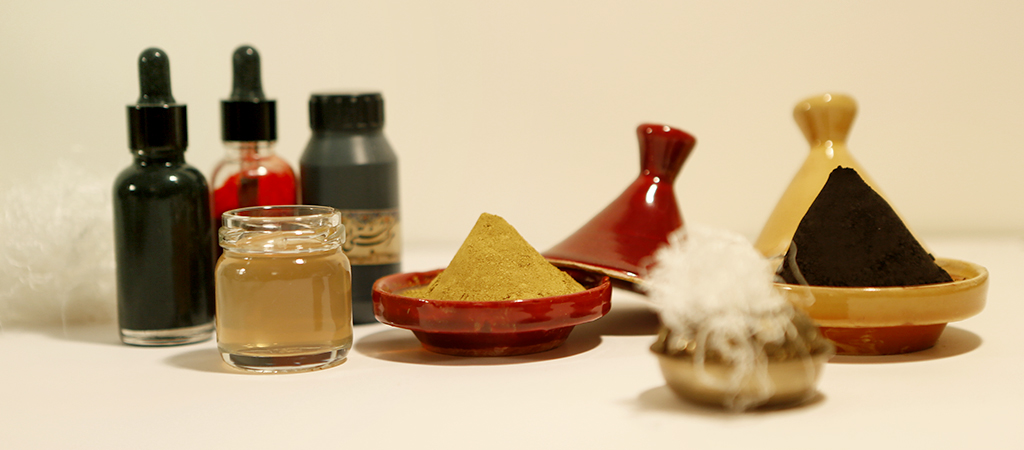Those materials which are used today are exactly the same ones which were used in ancient times in the practice of calligraphy; this is one of the reasons why the essence of this art has remained intact through the years. All the processes of preparation of materials are carried out traditionally and by hand, which provides this work with a purely traditional appearance.
Los materiales que se utilizan hoy en día siguen siendo los mismos que se utilizaban antiguamente, por lo que la esencia de este arte ha permanecido intacta con el paso de los años. Todos los procesos de preparación del material son hechos a mano, lo cual confiere a este trabajo un aspecto puramente artesanal.
THE PEN
“The reed pen is the forge of discourse, it executes what the heart has gathered and shapes what the feeling has merged”
_Abu Dulaf Al- Iyli
Islamic calligraphy is written with a pen (qalam) made of certain types of reed that grow in warm climates. The reed is sharpened with a special knife and its tip is reduced to the appropriate width according to whether the script is to be fine of bold. A small rectangular platform of ivory (or mother-of-pearl, tortoise shell, or bone) named miqatta is used for this purpose: the pen is laid on it, its tip is nipped and slit to permit the flow of ink. Large inscriptions require special pens made of wood.
EL CALAMO
"El cálamo es el forjador del discurso, lleva a término lo que el corazón ha reunido y modela lo que el sentimiento ha fundido."
_Abu Dulaf Al- Iyli
La caligrafía islámica se realiza utilizando un cálamo (qalam) hecho de ciertos tipos de cañas que crecen en climas cálidos. El cálamo se afila con un cuchillo especial y la punta se reduce para adaptarla a la anchura deseada para realizar escritura fina o gruesa. Una pequeña base rectangular de marfil (o madreperla, concha de tortuga o hueso) llamada miqatta se usa para este fin: el cálamo se coloca en ella y la punta se corta y se hiende para permitir que la tinta fluya. Los trazados de gran tamaño requieren cálamos especiales hechos de madera.
THE INK
“The stars of wisdom shine in the darkness of the ink”
_Califa Al-Ma´mun
Though a variety of substances were sometimes added to its composition, as natural pigments for certain colors, the basis of the ink used in islamic calligraphy is a suspension of soot obtained by burning such materials as beeswax, naphtha, or linseed oil, dissolving the residue in a solution of gum Arabic, and pounding the mixture for a long time. Inkwells were made first by hollowing out pieces of wood, and later with ceramics, glass, or metal. It is necessary to place a bunch of raw silk inside such containers, so that its fibres hold the ink.
LA TINTA
"Las estrellas de la sabiduría brillan en la oscuridad de la tinta"
_Califa Al-Ma´mun
Aunque diferentes sustancias se añaden en ocasiones a su composición, como pigmentos naturales para obtener ciertos colores, el elemento base de la tinta utilizada en la caligrafía islámica es una suspensión del hollín que se obtiene al quemar sustancias como cera de abeja, nafta o aceite de linaza que se disuelven en un solución de goma arábiga, batiendo la mezcla durante largo tiempo. Los tinteros se fabricaban al principio ahuecando piezas de madera, y más tarde de cerámica, cristal o metal. Es necesario colocar un trozo de seda cruda dentro, para que las fibras sostengan la tinta.
THE PAPER
The paper should go through a specific process before being used. Firstly, the paper should be died, and depending on the desired tone, different ingredients could be applied, being tea the most frequent. Once it is dry, a coat of wheat starch, fish jelly and three layers of ahar, which is a mixture of egg yolk and alum, will be rubbed on the paper. Each layer of ahar ought to be applied following a different direction, first from right to left, second from top to bottom and finally left to right. Through this process it is intended to completely cover the pores of the paper so that the ink may not penetrate them. After letting it dry for one or two days, it will be burnished roughly with a burnisher made of agate stone in order to completely polish its surface so that it is as smooth as possible. Once this process is finished, the paper should be kept for around one year to dry completely. The longer it is kept, the more suitable the paper will be for writing.
EL PAPEL
El papel debe pasar por un proceso específico antes de ser utilizado. Lo primero es el teñido del papel, dependiendo del color y la tonalidad que se le quiera dar, pueden utilizarse diferentes ingredientes aunque por lo general lo más frecuente es teñirlo con té. Una vez seco, se aplica sobre el papel una capa de almidón de trigo y gelatina de pescado y tres capas ahar, que es una mezcla de clara de huevo y alumbre. Cada capa de ahar debe aplicarse siguiendo una dirección diferente, primero de derecha a izquierda, luego de arriba a abajo y por último de izquierda a derecha. Con este proceso se pretende cubrir por completo los poros del papel para que la tinta no penetre en ellos. Después de haberlo dejado secar durante uno o dos días, se bruñe con fuerza con un bruñidor de piedra de ágata para pulir completamente la superficie y que esta quede lo más lisa posible. Terminado este proceso el papel debe guardarse durante un año mínimo para que se termine de secar. Cuantos más años pasen más favorable resultará el papel para la escritura.




